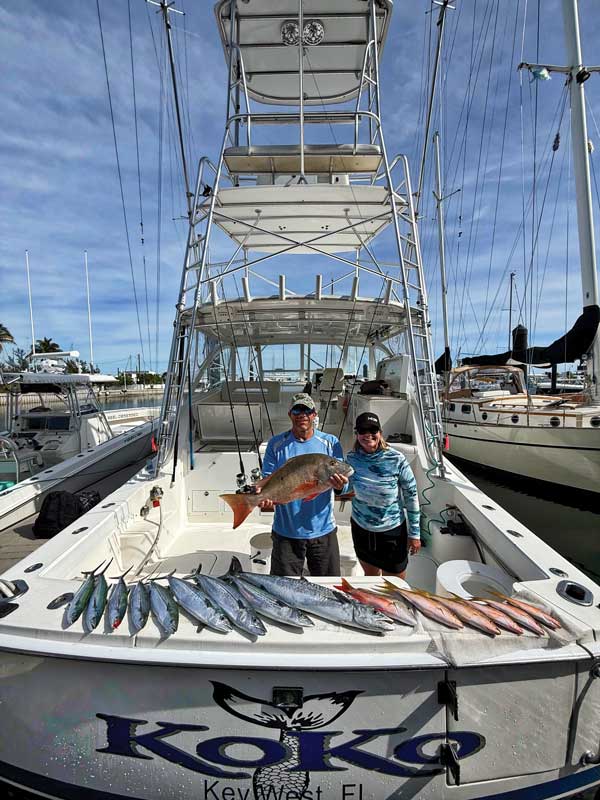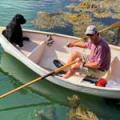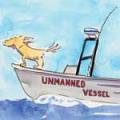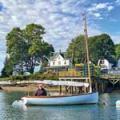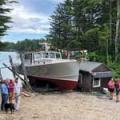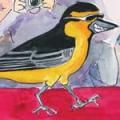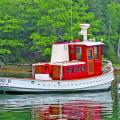A Fisherman’s Tale
What We Do in the (Winter) Shadows
Ok, it’s late February. Spring isn’t too far off. You think back 20-plus years to when there were stripers and bluefish hitting anything that looked or smelled like bait in the mouth of the Kennebec River. In our dreams, the fish are fat and our tackle has been carefully serviced and refreshed over the long winter, and it’s matched perfectly to the prey at hand.
So how do we prepare for the coming “season of our dreams” and spend our long winter evenings in joyful expectation versus woeful angst? Before we get into boat and gear preparation, consider these tried and true off-season practices for the Maine saltwater fisherman:
- Weep quietly where none of your friends can see you.
- Ask your doctor if he has a recommendation for a therapist. Assure the doctor it’s for a friend.
- Rent a smelt shack.
- Go to Key West and charter a boat.
- Buy a recliner and stream bass fishing shows.
- Learn how to pronounce “crankbait” like a native Alabamian.
- Follow the winter meetings of the Atlantic States Marine Fisheries Commission, Atlantic Striped Bass Board. As this is being written there is no firm decision on 2025 seasons and slot limits.
- Untangle your Sabiki rigs. This will use up an entire week, easily.
- Now that mental health has been addressed, make a checklist of actually useful preparations for the coming season.
 The author’s daughter snags a mackerel we could only dream about. Photo by Jason Riley
The author’s daughter snags a mackerel we could only dream about. Photo by Jason Riley
Rods
There is no image of joyful anticipation more powerful than a 10-year-old running out of a store with a new rod and reel. While we “adults” may have plenty of gear, a little TLC is important. Check the overall integrity of each rod. Nicks and scratches in the rod blank can develop into weak spots and cause a break. At least touch them up with some epoxy, nail polish, or UV cure resin. If the nick has broken some fibers, skilled help may be needed to reinforce it. West System epoxy has a nice little kit with small packs of resin, filler, and materials. Don’t use too much: a tapered rod blank is designed to bend smoothly; a stiff spot loads up adjoining areas unevenly. Think about back fusion surgery and the adjoining vertebrae. If you don’t know what this analogy means, be happy.
Inspect the line guides, particularly checking the wrappings for loose ends. Stick loose threads back down with the above “stickums.” A fly tier’s favorite is Sally Hansen Hard as Nails nail polish. If you are a fly tier, it is a great product to have in clear, clear with pearl glitter, white, black, and red. A serious fisherman may someday need to replace a line guide, particularly at the tip. The rest of us amateurs just wish we fished enough to wear out a guide. Rough areas on a guide from wear or cracks can easily cause a break-off.
Reel seats accumulate salt particles, which of course you rinse off with fresh water after each use. But in case you just might have skipped this step once or twice, check and clean accordingly. If you need to swap a malfunctioning reel while on the water, it is not good to find out it is corroded tight to the reel seat.
Reels
As mentioned above, these should get hosed off after each use in the salt. Ditto the rod. In the winter do a partial reel disassembly and clean and lube it. Even a cheap spinning reel can have a long life with a little care. A good one can last a lifetime. Look for reel lubes online or at tackle shops. WD 40 is good for unsticking parts but does not have the life of a thicker waterproof lube.
Check for easy operation of the bail and drag mechanism. If you buy a new reel, get it from a tackle shop and get expert advice. Keep the manual so you can take it apart and put it back together. Online resources are endless these days for advice, parts, and lubes.
Lines
With braid and monofilaments, at least remove and discard 10 yards or so off the end to get rid of the section with significant sun exposure and wear. Reversing the line so the end is now the tip is a good idea too, but can result in a mess if you don’t have some clean floor or a line winder. Run the line through a clean soft cloth when reeling it back on, in case your floor is not as clean as you think. Extra hands are useful here, cats are not. People who fish a lot change out lines annually. Fluorocarbon line has more UV resistance. Look up fluorocarbon vs. monofilament for the pros and cons of these line materials.
If you are fishing for stripers in particular, use stronger lines to shorten the fight so you can release the fish quickly to minimize mortality. Use non-offset circle hooks and flatten the barb; we are not meat fishing these days. The recent Young-of-Year seine samplings in the Chesapeake have been grim. These surveys document the annual spawning success of the stripers which comprise the vast majority of stripers we catch in Maine. Never keep a big fish even if it becomes legal again someday, all are females and full of eggs, as in millions.
To learn about the sampling, do an online search for “Young-of-Year seine sample Chesapeake.” The average had been 11 fish per haul; 2024 results showed a steep decline to 2 per haul.
 Back home up north, the author works on a “fly-dressed” jig (left) and an “Any Bait Fish” fly. Photos by Peter Bass
Back home up north, the author works on a “fly-dressed” jig (left) and an “Any Bait Fish” fly. Photos by Peter Bass
Make your own lures and flies
There is nothing more enjoyable than catching a fish on a fly or jig you have dressed yourself. Every saltwater tackle box contains metal head jigs and rubber tails that you assemble. Try adding a skirt of flashy hair or a silver tinsel strip to mimic a lateral line, or finish out a jig like a big fly. Find a friend who ties saltwater flies and has a vice and materials. If you can’t decide what to tie on remember, “It ain’t no use if it ain’t chartreuse.” This isn’t always true but chartreuse, white, and flashy is always a good place to start.
Fishing for stripers with a fly rod and your own flies is great fun, and creating the flies is the perfect way to spend a winter evening. L.L. Bean has classes, as do some tackle shops. Online searches will turn up dozens of resources. L.L. Bean has all the resources you need: equipment, flies, materials to make flies, books, and advice. Maine’s many fly shops have similar selections.
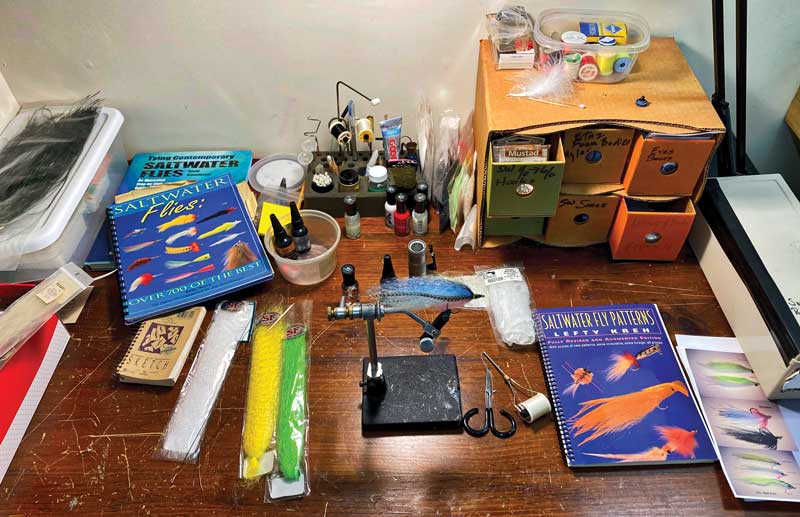 The author’s well-stocked workbench gets lots of attention as February turns to March. A mackerel imitation is in the vise on this day. Photo by Peter Bass
The author’s well-stocked workbench gets lots of attention as February turns to March. A mackerel imitation is in the vise on this day. Photo by Peter Bass
Do some scouting
Winter is a good time to scout out shore locations. In the Damariscotta River environs there is an organization called Coastal Rivers Conservation Trust which publishes maps of public access lands and trails. That, coupled with the appropriate NOAA chart, can lead you to shore locations with appropriate water depth and currents. If stripers are your prey of choice look for eddies and pools that will set up at different stages of the tide. Join USHarbors.com to get tide tables online so you know when to scout. The most flow will be at mid-tide. Check both rising and falling tides; stripers are ambush feeders and where they set up will depend on the direction of water flow.
Boats
Winter is a great time to web surf for new or used boats (a.k.a. boat porn). Remember the best fishing boat is the one you can afford. Along the coast, the most useful and affordable platform is often the center console. More fish are probably caught on simple, single-engine center consoles than any other configuration. Plus it is a most adaptable vehicle for family activities that may involve fishing or island hopping.
If your budget allows, a live well is good to have, but a few fresh or frozen mackerel in a cooler will take care of most bait needs. Once when fishing the Sasanoa River with a guide, we had great luck at anchor streaming a 4-inch mackerel strip 5 to 10 feet behind a bobber in a shallow channel on a falling tide.
Winter and early spring is the time to check lights, flares, life jackets, and other safety equipment. Don’t forget the first aid kit and be sure to have some way to get a hook out of a finger and bandage it properly. Start the year with fresh sun lotion and insect repellent. This writer has lost part of an ear to a lifetime of sunscreen carelessness, and mosquitos and ticks seem to be a lot more dangerous in New England than 50 years ago.
As this is written overlooking the Damariscotta River, the shortest day of the year is but a few days back, the temps are in the teens, and our stripers are in the Chesapeake. Let us take a minute to wish them a pleasant winter followed by riotous and fecund spawning in the coming months.
✮
Peter Bass is a returning MBH&H contributor. He wrote for 15 years including the column, “View From the Porch.” Prior to retirement in 2022, he worked for 10 years as a yacht broker in the Chesapeake before returning to Maine.
Related Articles
Share this article:
2023 Maine Boat & Home Show

Join Us for the Maine Boat & Home Show!
Art, Artisans, Food, Fun & Boats, Boats, Boats
August 11 - 13, 2023 | On the waterfront, Rockland, Maine
Click here to pre-order your tickets.
Show is produced by Maine Boats, Homes & Harbors magazine.







